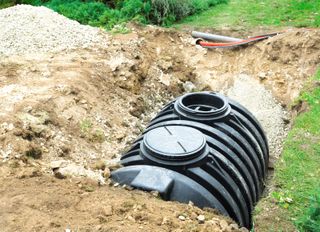What is a septic tank and is one worth installing?
Remote or rural properties are more likely to need a septic tank. Here's our guide on what they are and whether one is a sensible option for your build

'What is a septic tank?' is a question self builders and renovators might be asking if their new house isn't linked to the sewage network.
A second question might be whether a septic tank is worth installing rather than opting for alternativeoff-mains drainageoptions. Ultimately this choice w come down to the location of your house, the soil quality of the land around it as well as what your budget is in both the short and longer term.
Waste is gradually broken down in a septic tank, with liquid allowed to seep into the ground through a drainage field. Here is everything you need to know when it comes to septic tanks and whether one is worth installing for your project.
What is a septic tank?
A septic tank is an underwater sedimentation tank that treats wastewater from household plumbing produced by bathrooms, kitchen drains, and laundry, through biological decomposition and drainage.
Simply put, a septic tank system is an underground watertight container made of fibreglass, plastic or concrete and is usually rectangular or round.
They are used as part of a system to safely dispose of wastewater in homes that have poor drainage or are not connected to the mains sewerage network, such as those in rural areas.
They need to be emptied and regularly maintained so they don’t leak sewage into the surface or create blockages in toilets and sinks.

A septic tanks does however differ from a sewage treatment plant (although the term 'septic tank' is often applied colloquially to both). Sewage treatment plants have mechanical components and may or may not require power, while septic tanks do not.
A sewage treatment plant treats the waste – the process that ensures the waste has the least impact on the environment – whereas a septic tank simply separates it. Treatment means you can discharge the waste water straight to a local watercourse, but it is illegal to release untreated waste into a watercourse.
The water released by a septic tank is primary treated effluent, meaning it has only gone through one stage of treatment. When it is released from the tank it is still hazardous to the environment.
As such, septic tanks require a drainage field, a subsurface wastewater treatment facility which removes contaminants and impurities from the effluent released by the tank. The size of field required is determined by a percolation test, which evaluates how well the area drains the discharge.
Such a system relies on the subsoil being capable of receiving the final discharge without backing up and preventing the unit from working. This is determined by a percolation test. In the event that the ground is unsuitable, then it is usual to employ a sewage treatment plant.
How much does a septic tank cost to install?
Installing a new septic tank and drainage field for the first time willcost between £12,000 and £18,000while the average price for treatment plants is £10,000 to £15,000, says Elliot King, of Sutton-on-the-Forrest-basedYorkshire Septics, adding that these are ballpark figures.
For renovations, the cost is extremely variable and can range from £5,000 to £30,000 depending on what the existing set-up is.
“It’s very important to get a professional to look at it,” Elliot adds.

我应该空我的化粪池多长时间?
How frequently a septic tank needs to be emptied depends on two main factors:
- the size of the family
- and the size of the tank.
As a rough guide, a family of four with a six-person tank will find it needs emptying probably just once a year. (Treatment plants need maintenance once a year too.)
艾略特说化粪池然而持续很长me, but a drainage field is likely to need replacing in 10-30 years.
Am I allowed to install a septic tank?
Elliot King says you should check with your local water company as any property within 30 metres of the main sewage network must be connected to it. A treatment plant isn’t an option in this instance, so investigate first.
Finally, he says don’t be tempted to do the full installation yourself. “I wouldn’t advise it for a septic tank and definitely not a treatment plant."
Get the Homebuilding & Renovating Newsletter
Bring your dream home to life with expert advice, how-to guides and design inspiration, direct to your inbox.
Sam is based in Coventry and has been a news reporter for nearly 20 years. His work has featured in the Mirror, The Sun, MailOnline, the Independent, and news outlets throughout the world. As a copywriter, he has written for clients as diverse as Saint-Gobain, Michelin, Halfords Autocentre, Great British Heating, and Irwin Industrial Tools. During the pandemic, he converted a van into a mini-camper and is currently planning to convert his shed into an office and Star Wars shrine.
Most Popular

BySam Webb
Bring your dream home to life with expert advice, how-to guides and design inspiration, direct to your inbox.
Thank you for signing up to Homebuilding. You will receive a verification email shortly.
There was a problem. Please refresh the page and try again.
